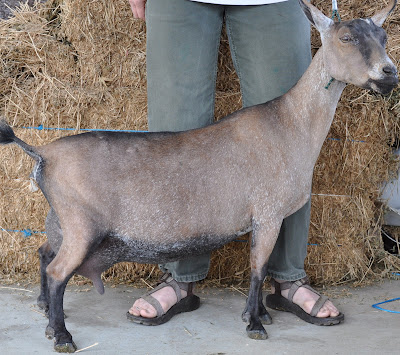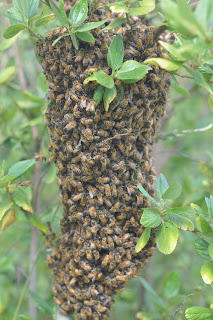I'll wait.
In 2011, Northern California was scheduled to have its normal appraisal sessions in September and/or October. Since I had freshened 42 does starting in early February, and was on the fence about several of them, and because I wanted to use LA to help me decide who could stay, and I was not about to milk all of them until the fall, I had to schedule a special session. This allowed me to have my appraisal session in May instead of October, but that convenience does cost a good deal more than being a part of the regular schedule. On the other hand, milking ten more does than you would like for an extra five months isn't free either.
The session was scheduled the one free weekend I had in May, with two show weekends before and two show weekends after. Several of the does had already been clipped for shows the previous weekends, though we still had upwards of 20 does to clip in about four days leading up to the appraisal.
 | |
| Before |
 |
| After |
One of the does I was really looking forward to having reappraised was Penny Wise, since I was somewhat depressed about her 82 as a two year old first freshener. As a second freshener, her udder really filled out, looking well balanced and capacious- her udder looked so good that I decided to take a chance and keep a buck out of her for myself and for those people wanting to breed their home milkers to a buck who would get them better capacity. But, because I had some lingering doubts, I sold her other two bucks as wethers- my philosophy being: I generally don't take chances with bucks, but if I do (see Guy Noir), he's going to stay here and mess with my breeding program, not someone else's.
 |
| Penny Wise, sired by Guy Noir |
The appraiser took one look at her udder as she was walking away and said "that's an excellent mammary system!", and I heartily agreed with him. She scored a VVEE 88, which was a huge relief to me, and gave me the confidence to take her to REDGA the next weekend. There, she easily won grand champion three rings in a row. Woot! A long time Toggenberg breeder came over to ask me about Penny Wise at the REDGA show and to offer congratulations, so I asked her if she could believe that Penny Wise had scored an 82 as a first freshener. She said that an 82 is really pretty good, especially if the doe is developing well. I was a little surprised, and asked a few more breeders about linear appraisal scores, and it turns out that I was being way too hard on my first fresheners in the past. Lesson learned-- it's always nice to find out that I can be more relaxed about things.
Overall, my three year old second fresheners (and the one three year old first freshener cough*BlackIce*cough) did well, mostly scoring in the 86-88 range, and I was happy with my first freshening yearlings and two year olds who scored in the 82-86 range.
The real highlight of the day for me was when Alum Root and her younger half sister Blizzard both ended up with scores of VEEE 90 on appraisal. They are both granddaughters of my much-loved and much-missed doe Sara, and the first Castle Rock does to score 90s on appraisal. Because I think very highly of Sara's daughters, granddaughters, and even some great granddaughters, it is especially nice to get independent verification of their niceness.
 |
| Blizzard looks much happier in real life |
I was allowed to have the does milked out before they got final mammary scores, allowing the appraiser to really get a good idea of texture and capacity. Many of our does scored E (excellent) in the mammary category (this is not to be confused with the E in the final four-letter score), and the appraiser told me that he gave more Es for mammary in my herd than he'd given out the previous year for all breeds. There were quite a few more excellents at this session than there had been four years previously during my first LA session, which can be seen as an indication that the herd is moving in the right direction.
Overall, it was another good session, though with so many does to appraise (three sheets worth!), it did take quite a bit of time. The appraiser even asked me if I didn't want to take a break and get off of my feet for a while, but I told him I'm pretty used to being on my feet for the vast majority of the day. Had I not had extra help from friends, it would have been a much longer day, since others were there to observe and to get animals out of the barn and put them away when they were done. Oh! And to milk (thanks Amanda!) before the girls got their final, final scores.
In looking over all of the scores for all of the categories and comparing them to the 2010 appraisal and the 2008 appraisal, I like the direction that the scores are moving in as the herd evolves. I'm already looking forward to our 2012 appraisal session...I should say, I'm looking forward to seeing the scores, not so much the washing and shaving of all of the senior does again!






















